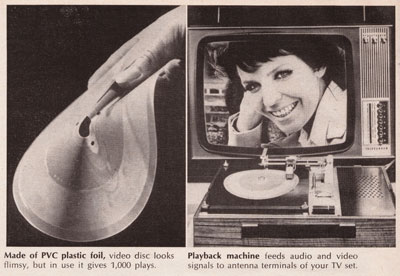
 |
Search | FAQ | US Titles | UK Titles | Memories | VaporWare | Digest | |||||||
| GuestBook | Classified | Chat | Products | Featured | Technical | Museum | ||||||||
| Downloads | Production | Fanfares | Music | Misc | Related | Contact | ||||||||
| CED in the History of Media Technology | ||||||||||||||

The Teldec or TED VideoDisc system was the first postwar consumer disc system to be given a public demonstration in Berlin, Germany in June 1970. The system had been under development for seven years by the German firms AEG Telefunken and Teldec (Teldec was a joint subsidiary of Telefunken and English Decca). Like the other prototype VideoDisc systems that followed, the player was similar in appearance to an audio turntable. The existence of the Teldec system legitimized RCA's VideoDisc research group (at the expense of Holotape), and at the same time energized disc research at RCA, as there was now a competitor.
The Teldec system used paper-thin PVC discs suspended in air only by the central hub. These thin grooved discs became rigid when rotating at the 1500 RPM playback speed. The 1970 prototype demonstration provided 5 minutes of B&W video from an 8" disc, and changers that could play a stack of discs were being developed. The pickup arm tracked the disc linearly (same as CED), with each groove corresponding to one television frame, making effective freeze frame possible. The diamond-tipped stylus used the piezoelectric effect, wherein a crystal produces voltage proportional to the mechanical stress applied. The crystal, located directly above the diamond stylus, received this variable stress from the hill-and-dale grooves of the disc. The Teldec system went on the market in 1975, thus also becoming the first postwar consumer VideoDisc system to be marketed.